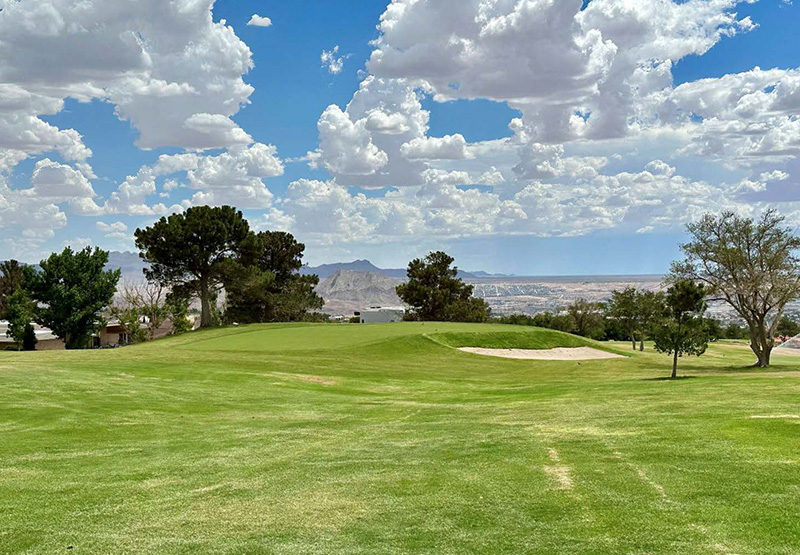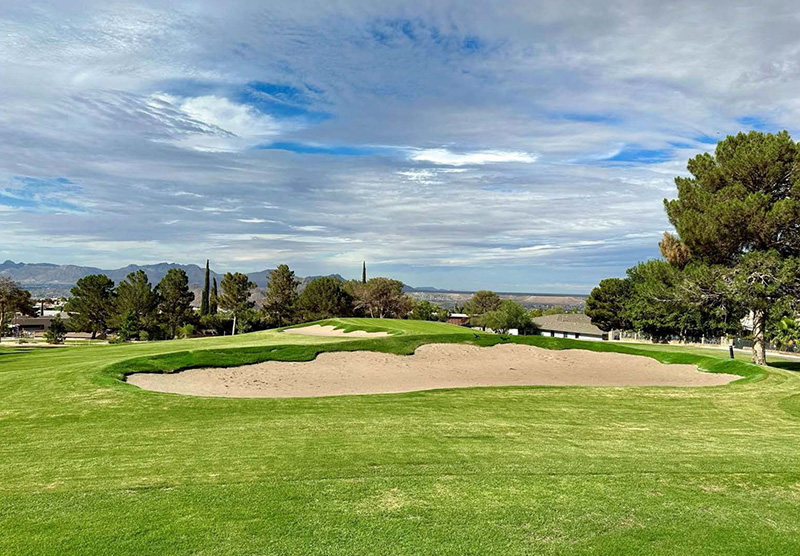
Bill Newton, a six-year GCSAA member, jumped with both feet into his first lead superintendent position at Coronado Country Club. Photo courtesy of Bill Newton
Editor’s note: The following article was supplied by Heritage Links. All product claims, research cited and other information is directly from the company.
It’s August in El Paso and Bill Newton, a self-described “total weather nerd,” is still adjusting to the humidity. Newton, the superintendent at Coronado Country Club, arrived here in March, two months into a green and bunker renovation led by architect Bill Bergin. Newton’s previous stop was Desert Mountain in Scottsdale, Arizona, where the air is pretty dry. Here on the Mexican border, 4,300 feet above sea level, he expected atmospheric conditions to be drier still.
“I am bit surprised by the humidity: 60% some days. I had no idea it got that moist,” says Newton, a six-year GCSAA member. He was on site maybe six weeks before Heritage Links started seeding his new putting surfaces with a 777 bentgrass blend. “I’m pretty comfortable in my role today. The more mature greens are very comfortable. But they got a little puffy in the humidity after some storms came through in July. Lightning releases nitrogen in the atmosphere.”
Wait. What?
The new superintendent, still less than four months into his first job overseeing a full-length golf course, explains that lightning allows nitrogen to be broken apart in the atmosphere. “When that happens, it’s more readily available to the plant. So, when that sort of storm comes through, what’s the effect? Or rather, what do you have to do in response? Less fertilization load,” Newton says.
In August 2023, Newton was tending to the par-3 No. 7 course at Desert Mountain Club, some 435 miles to the west and 2,100 feet closer to sea level. About the same time, his predecessor at Coronado CC was dealing with damaged greens following an agronomic mishap, according to Club President Mark Cossentino.
George Shook, the club’s general manager, says that before any of that unfortunate business went down, the old push-up greens “didn’t flush salts,” a long-term side effect of the effluent Coronado uses to irrigate the course. The greens featured five or six different strains of poa annua. In fact, the Board of Directors had already resolved to rebuild the putting surfaces before they were damaged. “It was a kind of silver lining,” Shook says.
In response, the club retained Bergin’s architectural services. Houston-based Heritage Links won the construction bid and broke ground Jan. 15, 2024, under the direction of Heritage project manager Sergio Cadengo.
“It was an amazing thing to witness,” says Cossentino. “They showed up here with 20 guys and just started flying around. The last green was planted June 3, and all 33 bunkers, all the new cart paths and tees, they did all that in the meantime.”
Newton dropped directly into this hive of activity. He never blinked.
“Bill knows his agronomy. Very focused and he brought tremendous energy to this project,” says Shook. “The greens are maturing each day. The hope is that we have the place ready for our Capers Tournament in late September.
“There’s a lot of credit to be shared on this project. Heritage Links has been so professional, such amazing technicians and communicators. Bill Bergin’s new greens have completely changed this golf course. And Bill Newton never missed a beat. But I’ll say this, too: The members stayed with us throughout this renovation. We hope to reward them. They are totally excited with what they’ve seen in the way of an end-product,” Shook says.

Coronado Country Club's third hole.Photos courtesy of Coronado Country Club
Improving the putting surfaces
Shook has been through the course-renovation process before at the Country Club of Mobile with architect Jerry Pate and Wildcat Cliffs CC in the western North Carolina mountain town of Highlands. The architect on that job, completed in 2008, was Bergin.
“During the interview process, we got a real strong sense for what the design issues were. The greens just weren’t at all receptive,” says Oscar Rodriguez, a senior vice president with Heritage Links. “Very difficult to putt on, with only 2-3 pin placements per surface. You couldn’t see the ball land in certain spots, because of the changes in elevation.”
Rodriguez continues: “This was the first time I’ve seen Bill Bergin’s work firsthand, but hiring him was the best decision the club could have made. And once they did hire him, the club got out of the way and let him do his thing. That’s rare. So many times a club says to us, ‘The greens need revamping, but please GPS them and put them back exactly as they were pre-construction.’ This was definitely not that. They told the architect what they told me, and Bill’s redesign addressed every issue. He changed the whole concept at Coronado — on a site that never made a single thing straightforward.”
Coronado CC was built in the late 1950s on the side of mountain. Both Newton and Bergin call the parcel “wedge-shaped,” and it’s an apt description — the face of a pitching wedge is typically 46-48 degrees. The property here is steep, rocky, hemmed in by housing and largely treeless.
Bergin says the putting surfaces were always the dominant design feature, but they simply were not up to the task.
“Most of the former green complexes ran off into the far reaches of the property,” Bergin explains. “That created challenge, but not in a good way. We created more room to accommodate less than perfect golf.”
Bergin says the results allow for much more flexibility and improved playing conditions suitable to the course’s outstanding scenery.
“Coronado sits at the foot of some beautiful, much higher mountains. With Mexico to the south and New Mexico to the west, let me tell you: There are some gorgeous sunsets every evening,” Bergin recalls. “The whole course setting is very appealing, visually, but the original course didn’t have much. Today we have green complexes with six pin positions minimum. Bill Newton can set it up very tough or very playable. The slopes on the old greens were often too much for modern bents. Now the slopes match the green speed capabilities.”
Rodriguez and Shook each noted Bergin’s flexibility on site. For example, the club couldn’t afford to install brand new irrigation wall to wall — only around the new green complexes.
“So, what happens with that kind of project is, you’re really trying to create value for the money spent,” Bergin explains. “And that means you’re going to have restrictions. The bunkering at Coronado used to sit on top of the ground. We wanted the new bunkers cut into the ground, into the hillsides. So we worked around the existing irrigation to do that. Out of 33 bunkers, I’d say we probably had to hammer only 5 of them into place. We had to have the jackhammer on site to get the new irrigation in anyway. It worked out quite well.”

The eighth hole at Coronado Country Club.
Jumping in with both feet
It’s never easy for a new course superintendent who shows up after the greens have failed, but Newton took the practical approach. “I’m in the dark about that situation, and I want to be,” he says.
Besides, there was plenty to keep he and his crews occupied. Starting March 14, 2024, there were 25 acres of Tiff Tuff surrounds to sod and nurture, then 2.5 acres of 777 bentgrass greens to plant and keep alive.
“Bill took over right where the superintendent needs to really earn his keep,” Rodriguez says. “The other superintendent laid the groundwork when it came to building the greens. When Bill showed up, it was go time.”
Rodriguez doesn’t say that lightly. “The moment we started sodding the surrounds, the winds picked up. Growing bent in a dry climate, with high temperatures and high winds? We had to get some covers,” he says. “Most projects — maybe new TifEagle greens, in a warm-season climate — we’ll cover those. But growing greens in El Paso, in summer, with high winds? And you’re asking the guy to reopen in late September? That’s pretty tough. But he worked his butt off. Made it work. I’m impressed by him.”
Prior to arriving in El Paso, Newton had never served as head superintendent at a full-length golf course. But greens are greens, and the 007 bentgrass he cultivated at Desert Mountain proved a solid foundation for the 777 grow-in he inherited at Coronado.
What’s more, as an assistant at the J.W. Marriott Camelback Resort, he had been involved in a full-on bunker renovation. That got his attention. When his neighbor superintendent at Desert Mountain led a big renovation, a light went on.
“I’ve always been interested in that side of things,” Newton says. “Heritage is the best at what they do and it’s been amazing to watch them work. Any issues, big or small, they get me on the horn. If I need help moving palettes, they’re there to help. Now that I’m really in the middle of a renovation, I’ve been surprised and impressed by how mutual and symbiotic that relationship is.”
By late July, Newton said the process, while not always smooth, was successful.
“We’ve had our challenges. We got most of the greens seeded in early May but the others were only seeded [June 3],” Newton said. “We were just catching up when the pump station crashed! We’ve had 90% recovery, which is pretty phenomenal. Even our weakest greens — we’ll be ready to mow them next week. When those greens got hit hard, I got aggressive with the NPK, a huge factor in their recovery. Kurt Nortman from Ameriturf and DCM’s products — they’ve been a huge help.”

Coronado Country Club's 14th hole.
Part of that success, he notes, comes from the course’s dedicated crew. “We’ve already had some pythium and brown patch. And we’ve already punched them out,” Newton said. “Our guys, I’m so proud of them. They saw the discoloration and the patterns, called me and I came running out there. Hit it with a Lexicon application, then a Banol application. The double whammy just knocked it out.”
When Newton checked in again in August, the dust was beginning to clear. The Sept. 17 tournament opening didn’t seem so far away, or particularly outlandish. The day-to-day agronomy routines that all superintendents crave were beginning to fall into place.
“This has got to be some of the worst water in the U.S.,” Newton says, noting that it wasn’t so great in Scottsdale. But there’s a difference between treated water and the outright effluent he’s dealing with at Coronado. “I buffer all my tanks with salicylic acid, to reduce alkalinity. It also helps reduce whatever’s already in the soil, to reduce the fight-or-flight impulse in the plant. I use it everywhere and the amount of greenage I’ve seen come up is pretty extraordinary. Other than that, we’re constantly aerifying and top-dressing.”
Looking back on the experience so far, Newton says he’s grateful to have the chance to dive in, and for the support he’s had along the way.
“It’s been a wild ride, but I so appreciate the opportunity,” he says. “The club and Heritage and Bill Bergin have all had my back throughout. You know what they say: Your actions speak for you. And we have performed, the crew most of all.”
Hal Phillips is the managing director of Mandarin Media and a frequent contributor to GCM.